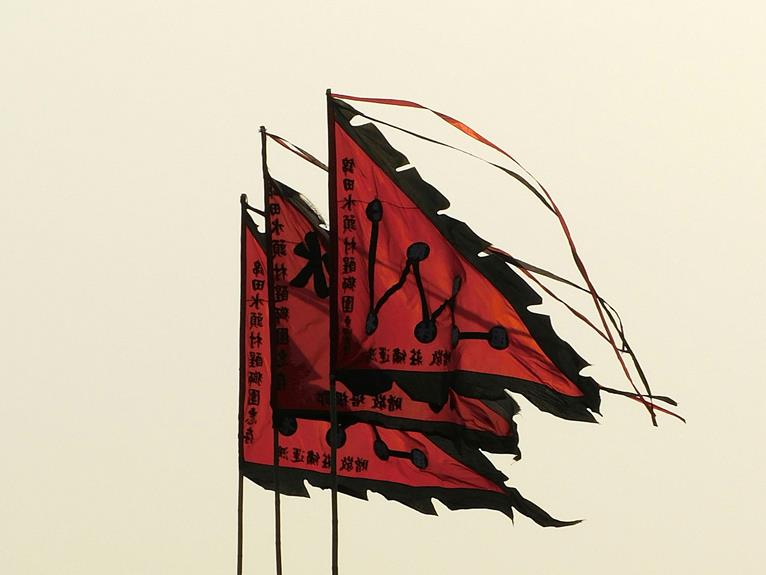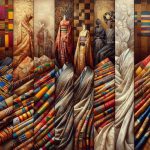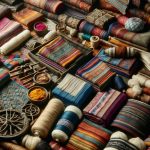When you consider the fabric of damask, you're not just looking at a textile; you're encountering centuries of history and craftsmanship. Originating in ancient Syria, this fabric has woven its way through time, reflecting cultural narratives and evolving designs. Its unique patterns and luxurious feel have made it a staple in both fashion and home decor. But what truly sets damask apart is its journey through various cultures and eras, raising questions about its significance and modern relevance. What might you discover about the stories behind those intricate designs?
Table of Contents
Historical Origins of Damask
Damask fabric originated in ancient Syria, where skilled artisans wove intricate patterns that showcased their exceptional craftsmanship. You'll find that its name comes from the city of Damascus, a major trade hub in the early centuries. As trade routes expanded, the popularity of damask spread throughout the Mediterranean and into Europe, especially during the Middle Ages.
When you think of damask, envision luxurious textiles that adorned the homes of the wealthy. In medieval Europe, it became a sign of prestige, often used for curtains, tablecloths, and garments. You can appreciate how the fabric's unique ability to display complex designs made it a favorite among nobility.
As you explore the evolution of damask, you'll notice its adaptation to various cultures. Each region added its own flair, incorporating local motifs and techniques, which enriched the fabric's legacy. By the Renaissance, damask was firmly established in European textile markets, thanks to its durability and beauty.
Unique Characteristics of Damask
What sets damask apart is its distinctive reversible pattern, which creates a stunning visual effect that enhances any setting.
You'll appreciate how this intricate design adds depth and character to both formal and casual environments.
Damask isn't just beautiful; it's also functional, making it an ideal choice for a variety of applications.
Here are four unique characteristics of damask that you should know:
- Durability: Made from high-quality fibers, damask is designed to withstand regular use, ensuring longevity in your home textiles.
- Versatility: Its reversible nature allows you to switch up the look of a room easily, making it suitable for curtains, table linens, and upholstery.
- Luxurious Feel: The smooth texture of damask adds a touch of elegance, making it perfect for special occasions or everyday luxury.
- Cultural Significance: With roots in ancient textiles, damask carries a rich heritage that connects you to centuries of craftsmanship and artistry.
Incorporating damask into your decor not only elevates your space but also brings a piece of history into your home.
Traditional Weaving Techniques
When you explore traditional weaving techniques for damask fabric, you'll uncover ancient craftsmanship methods that have stood the test of time.
You'll also see how innovations like the Jacquard loom transformed the weaving process, enhancing complexity and design.
Additionally, regional variations add unique flavors to this beautiful fabric, reflecting local artistry and culture.
Ancient Craftsmanship Methods
Throughout history, artisans have employed intricate weaving techniques to create the luxurious texture and patterns that define damask fabric. These traditional methods require skill, patience, and a deep understanding of the materials involved. You'd be amazed at how these techniques contribute to the unique qualities of damask.
- Loom Types: The type of loom used, whether hand-operated or more complex, greatly affects the end result, allowing for various designs and fabric weights.
- Thread Selection: Artisans carefully choose threads, often using silk or linen, to enhance the fabric's sheen and durability, resulting in a visually stunning piece.
- Weaving Patterns: Each design, often inspired by nature or historical motifs, involves a meticulous process of interlacing threads, creating a reversible fabric with depth and dimension.
- Finishing Techniques: After weaving, finishing processes like washing, pressing, and dyeing ensure the fabric not only looks beautiful but also feels luxurious against the skin.
Jacquard Loom Innovations
Jacquard loom innovations revolutionized the weaving process, allowing artisans to create intricate damask patterns more efficiently than ever before. By introducing a system of punched cards that dictated the movement of the warp threads, the Jacquard loom freed weavers from the limitations of manual techniques. This meant you could produce complex designs with less time and effort, enhancing both creativity and productivity.
Here's a quick overview of the Jacquard loom's key features:
| Feature | Description |
|---|---|
| Punched Card System | Controls the weaving pattern automatically |
| Increased Efficiency | Reduces time spent on setup and weaving |
| Design Complexity | Enables creation of intricate patterns |
| Versatility | Adapts to various fabric types, including silk |
With these innovations, you can appreciate how the Jacquard loom not only preserved traditional craftsmanship but also pushed the boundaries of what was possible in fabric design. As a result, damask became not just a fabric but a canvas for artistic expression, combining heritage with modern technology.
Regional Weaving Variations
Artisans across different regions have developed unique weaving techniques that contribute to the rich diversity of damask fabric, showcasing cultural influences and local traditions. Each area has its own distinct style that reflects its heritage, creating a fascinating tapestry of patterns and textures.
Here are four notable regional variations in damask weaving:
- Italian Damask: Renowned for its intricate floral designs and vibrant colors, Italian damask often features elaborate motifs that are inspired by Renaissance art.
- Chinese Silk Damask: Characterized by its luxurious feel and delicate patterns, Chinese silk damask traditionally includes symbols of prosperity and good fortune, often used for ceremonial garments.
- Middle Eastern Damask: This style often incorporates geometric patterns and rich colors, influenced by Islamic art, making it a popular choice for home textiles and decorative pieces.
- Eastern European Damask: Known for its bold, contrasting colors and heavy textures, Eastern European damask often showcases folk motifs, reflecting the region's cultural heritage.
Cultural Significance Across Regions
Damask fabric carries deep cultural significance in various regions, often reflecting the heritage and artistry of the communities that produce it.
In Europe, particularly in countries like Italy and France, damask has been synonymous with luxury and elegance, often used in royal households and formal occasions. You can see how these fabrics embody the craftsmanship and historical narratives of the artisans.
In the Middle East, damask represents a rich tradition of textile production, where intricate designs tell stories of cultural identity and pride. When you wear or use damask from this region, you're not just enjoying its beauty; you're connecting with centuries of tradition.
In Asia, particularly in China, damask often showcases vibrant colors and intricate motifs that celebrate nature and mythology. You'll find that each piece is a celebration of artistry, conveying cultural values and stories through its patterns.
Whether you're draping it over furniture or wearing it as clothing, damask serves as a bridge to the past, allowing you to appreciate the diverse cultural narratives woven into its fabric. You're not just using a material; you're engaging with a rich tapestry of human experience.
Evolution of Damask Patterns
Throughout history, patterns have evolved significantly, transforming damask into a canvas that reflects changing tastes and cultural influences. As you explore the journey of damask patterns, you'll notice shifts in style, technique, and design that resonate with different eras and societies.
- Medieval Origins: Early damask featured intricate, woven motifs, often inspired by nature and mythology, showcasing the craftsmanship of the time.
- Renaissance Flourish: In this period, patterns became more elaborate, incorporating floral and geometric designs, aligning with the broader artistic movements of the era.
- Baroque Opulence: The Baroque period introduced bold, dramatic patterns, characterized by rich colors and heavy textures, appealing to the aristocracy's desire for luxury.
- Industrial Revolution: With advancements in machinery, damask patterns became more accessible, leading to a variety of styles that catered to the growing middle class.
These stages highlight how damask has adapted over time, making it not just a fabric, but a historical narrative that tells the story of human creativity and cultural evolution. As you appreciate this fabric, recognize the artistry woven into each pattern.
Modern Applications and Trends
Today, you'll see damask fabric making a comeback in interior design, adding elegance and texture to modern spaces.
The fashion industry is also reviving this classic material, showcasing it in contemporary collections.
Plus, with a growing focus on sustainable practices, designers are finding innovative ways to create damask that's both stylish and eco-friendly.
Interior Design Innovations
Exploring innovative applications of damask fabric in modern interior design reveals a blend of timeless elegance and contemporary style. You can elevate your living spaces by incorporating damask in unique ways that resonate with today's aesthetic preferences.
Here are some trends to consider:
- Accent Walls: Use damask wallpaper to create a stunning focal point in any room, adding depth and sophistication without overwhelming the space.
- Cushions and Throws: Incorporate damask-patterned cushions or throws on sofas and beds. This adds a touch of luxury while maintaining comfort.
- Window Treatments: Consider luxurious damask drapes to frame your windows. They not only enhance natural light but also bring an air of grandeur.
- Upholstered Furniture: Reupholster chairs or sofas with damask fabric for a chic upgrade. This timeless fabric provides a rich texture that complements various design styles.
Fashion Industry Revival
Damask fabric is making a bold comeback in the fashion industry, bringing a luxurious touch to modern designs and redefining elegance in everyday wear. You'll find it gracing everything from statement dresses to chic accessories, adding depth and texture that catch the eye. Designers are creatively incorporating damask patterns, often blending traditional motifs with contemporary silhouettes, ensuring that this rich heritage fabric feels fresh and relevant.
Here's a quick look at how you can see damask making waves today:
| Application | Trend |
|---|---|
| Statement Pieces | Bold, oversized designs |
| Accessories | Elegant bags and shoes |
| Homewear | Stylish loungewear sets |
As you explore your wardrobe, consider adding damask to elevate your style. Whether you opt for a stunning dress or a subtle accessory, this fabric can transform your look. It's not just about nostalgia; it's about embracing timeless elegance in a modern world. So, why not experiment with damask and redefine your fashion statement? You might just find your new favorite piece!
Sustainable Fabric Practices
Embracing sustainable fabric practices is transforming the fashion landscape, allowing you to make eco-friendly choices without sacrificing style. As you explore modern applications of damask and other fabrics, you'll discover that sustainability is now at the forefront of design and production.
Here are four key trends to consider:
- Eco-Friendly Materials: Many designers are opting for organic cotton, hemp, and recycled fibers, minimizing environmental impact.
- Ethical Production: Brands are focusing on fair labor practices, ensuring everyone in the supply chain is treated with dignity and respect.
- Zero-Waste Design: Innovative techniques are emerging that reduce fabric waste during production, allowing you to wear unique pieces without guilt.
- Local Sourcing: Supporting local artisans and manufacturers not only strengthens communities but also reduces carbon footprints associated with transportation.
Caring for Damask Fabrics
To keep your damask fabrics looking their best, you'll need to follow some specific care guidelines.
First, always check the care label before washing. Most damask fabrics are machine washable, but some may require dry cleaning. If machine washing, use a gentle cycle with cold water to avoid fading and shrinking.
When it comes to detergent, opt for a mild, color-safe option. Avoid bleach, as it can damage the fibers and affect the fabric's intricate patterns.
After washing, hang your damask items to air dry, as high heat from dryers can weaken the fabric.
If you need to iron your damask, do so on a low setting while the fabric is slightly damp. Using a pressing cloth can also help protect the delicate fibers.
For storage, keep your damask in a cool, dry place, away from direct sunlight to prevent discoloration.
Frequently Asked Questions
How Can I Identify Authentic Damask Fabric?
To identify authentic damask fabric, feel the texture—it's usually smooth and luxurious. Check for intricate reversible patterns, and look for silk or high-quality cotton. Authentic damask often has a weighty feel and a subtle sheen.
Is Damask Fabric Suitable for Outdoor Use?
Damask fabric's not ideal for outdoor use, as it lacks durability against weather elements. If you need a fabric for outdoor settings, consider materials specifically designed to withstand moisture, sun, and wear.
What Colors Are Traditionally Associated With Damask?
Traditionally, damask features rich, deep colors like red, gold, and blue. You'll often see intricate patterns in these hues, adding elegance to any space. These colors create a timeless, luxurious look that enhances your decor.
Can Damask Be Used for Upholstery Projects?
Absolutely, you can use damask for upholstery projects! Its durability and elegant patterns make it a great choice for chairs, sofas, and cushions. Just ensure it suits your overall decor style for the best effect.
Where Can I Buy High-Quality Damask Fabric?
You can buy high-quality damask fabric at specialized fabric stores, online retailers like Etsy or Amazon, and home decor shops. Always check reviews and product descriptions to ensure you're getting the best quality available.
- Exploring Different Types of Chamois Fabric - June 22, 2025
- What Is Micro Chamois Fabric? Everything You Need to Know - June 22, 2025
- The Meaning and Description of Chamois Fabric - June 22, 2025







